Strategies for Equality and Diversity at Unilever: Research Report
VerifiedAdded on 2023/01/18
|17
|3590
|93
Report
AI Summary
This report examines equality and diversity in the workplace, focusing on Unilever as a case study. It explores the benefits of a diverse workforce, the challenges of workplace discrimination, and strategies to promote equality and inclusion. The report begins with an introduction to workplace diversity, defining key terms and highlighting the importance of an inclusive environment. It then delves into the research methodology, including research questions, a literature review, and data collection methods. The study analyzes various types of discrimination, including those based on gender, culture, disability, religion, and race. The research investigates the advantages of employing a diverse workforce, barriers to promoting diversity, and potential solutions. Data analysis and findings are presented, followed by a reflection, recommendations, and a conclusion that summarizes the key insights and suggests actionable strategies for fostering a more equitable and inclusive workplace. The report aims to identify strategies and approaches to avoid workplace discrimination and promote equality at workplace, specifically using Unilever as the case study.
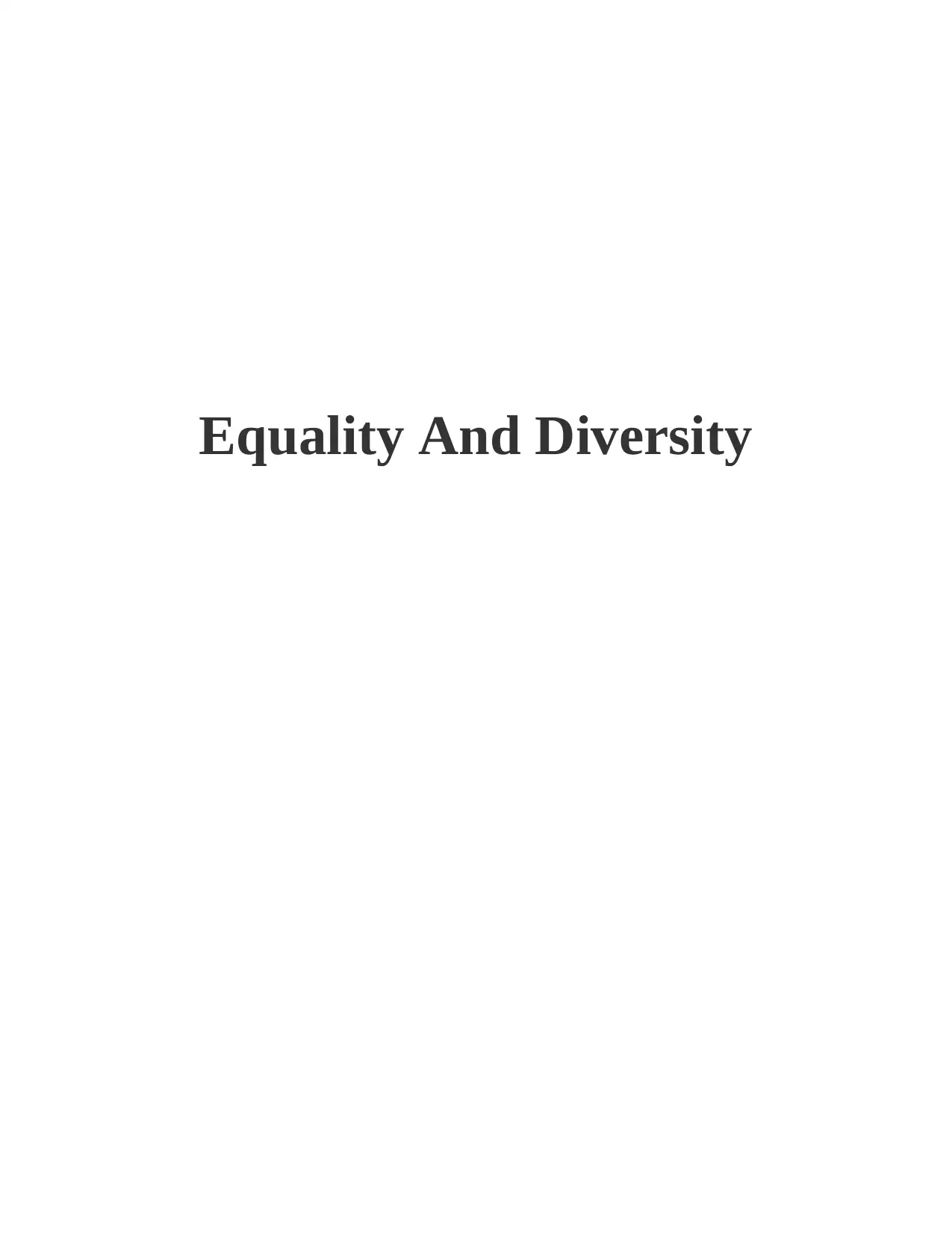
Equality And Diversity
Paraphrase This Document
Need a fresh take? Get an instant paraphrase of this document with our AI Paraphraser
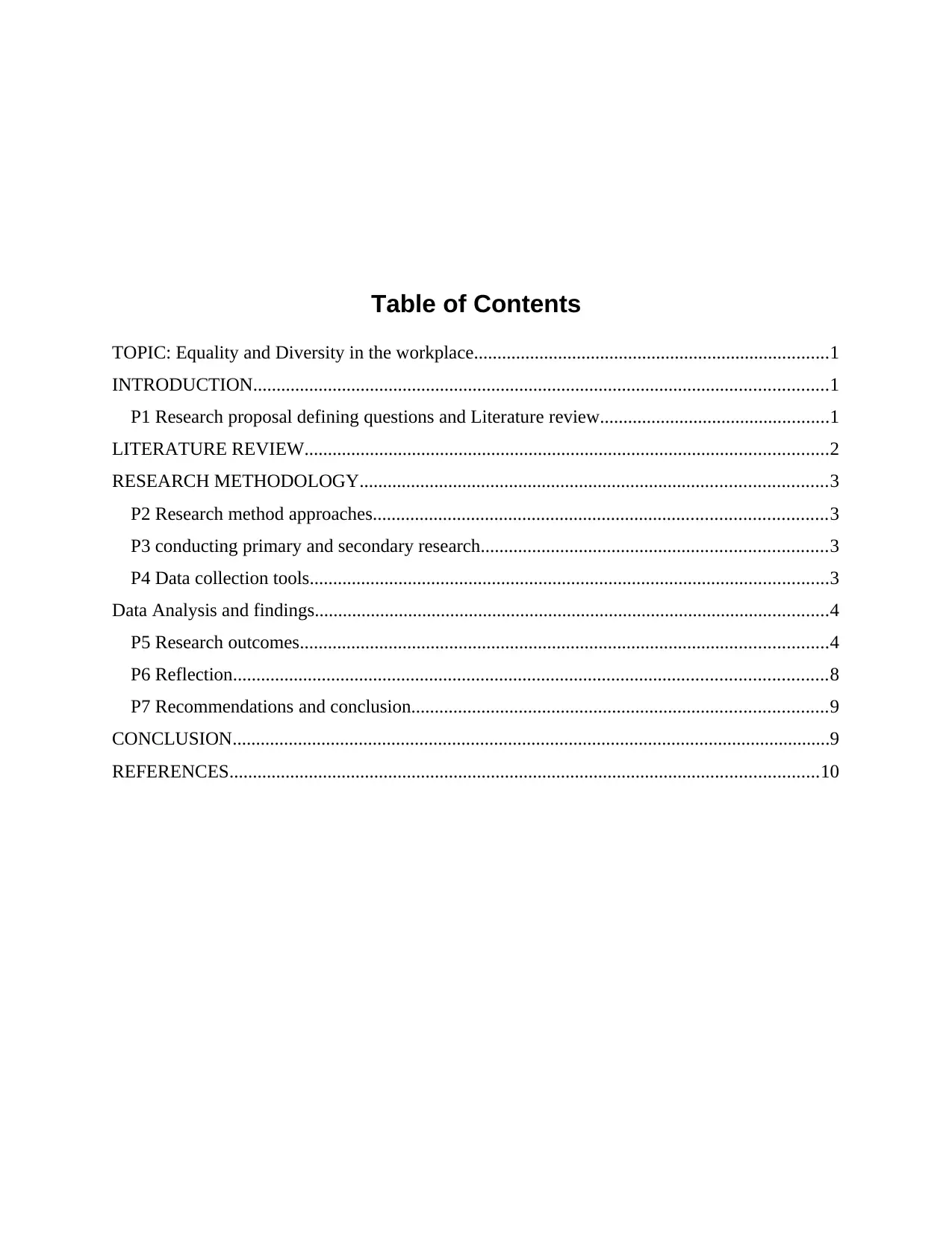
Table of Contents
TOPIC: Equality and Diversity in the workplace............................................................................1
INTRODUCTION...........................................................................................................................1
P1 Research proposal defining questions and Literature review.................................................1
LITERATURE REVIEW................................................................................................................2
RESEARCH METHODOLOGY....................................................................................................3
P2 Research method approaches.................................................................................................3
P3 conducting primary and secondary research..........................................................................3
P4 Data collection tools...............................................................................................................3
Data Analysis and findings..............................................................................................................4
P5 Research outcomes.................................................................................................................4
P6 Reflection...............................................................................................................................8
P7 Recommendations and conclusion.........................................................................................9
CONCLUSION................................................................................................................................9
REFERENCES..............................................................................................................................10
TOPIC: Equality and Diversity in the workplace............................................................................1
INTRODUCTION...........................................................................................................................1
P1 Research proposal defining questions and Literature review.................................................1
LITERATURE REVIEW................................................................................................................2
RESEARCH METHODOLOGY....................................................................................................3
P2 Research method approaches.................................................................................................3
P3 conducting primary and secondary research..........................................................................3
P4 Data collection tools...............................................................................................................3
Data Analysis and findings..............................................................................................................4
P5 Research outcomes.................................................................................................................4
P6 Reflection...............................................................................................................................8
P7 Recommendations and conclusion.........................................................................................9
CONCLUSION................................................................................................................................9
REFERENCES..............................................................................................................................10
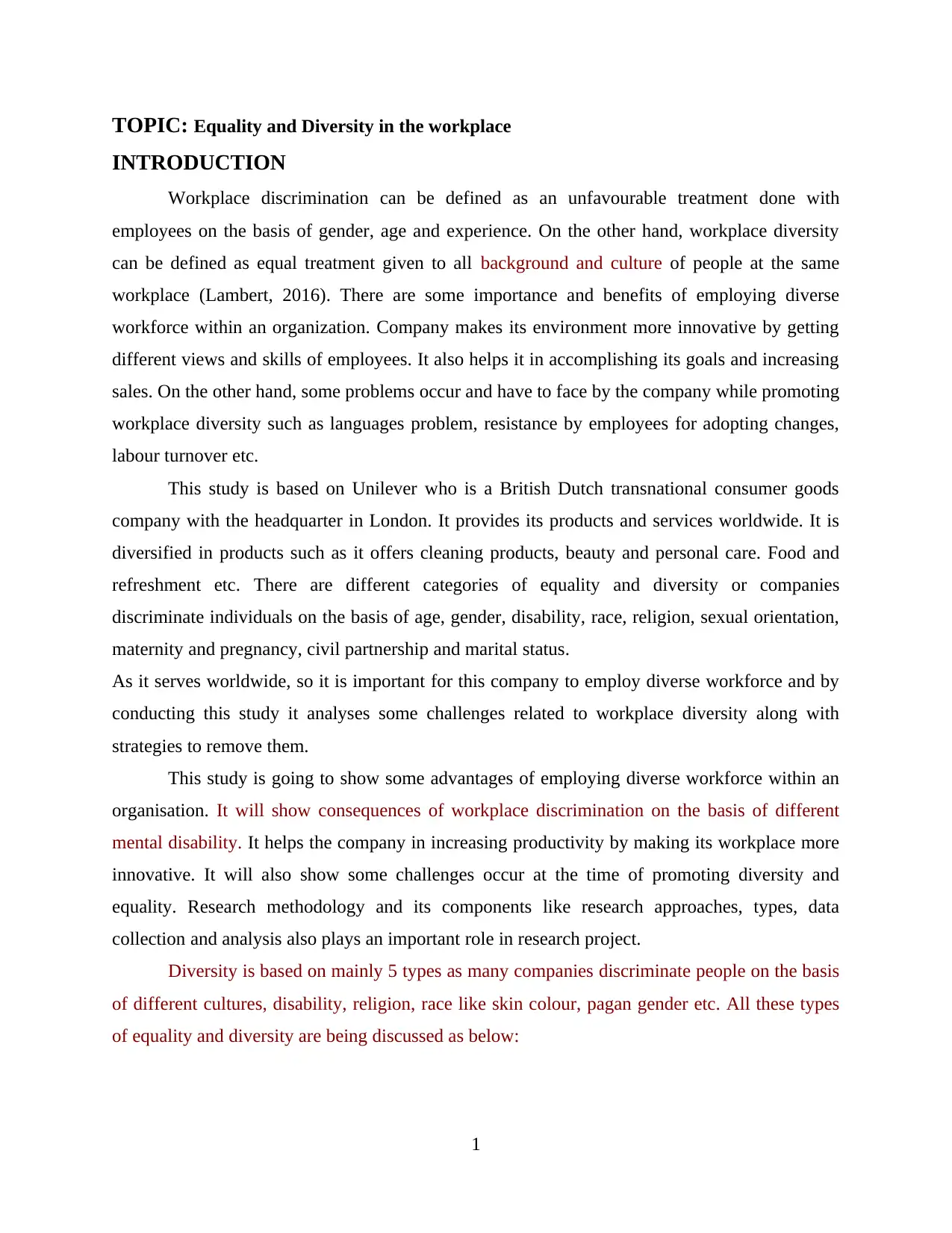
TOPIC: Equality and Diversity in the workplace
INTRODUCTION
Workplace discrimination can be defined as an unfavourable treatment done with
employees on the basis of gender, age and experience. On the other hand, workplace diversity
can be defined as equal treatment given to all background and culture of people at the same
workplace (Lambert, 2016). There are some importance and benefits of employing diverse
workforce within an organization. Company makes its environment more innovative by getting
different views and skills of employees. It also helps it in accomplishing its goals and increasing
sales. On the other hand, some problems occur and have to face by the company while promoting
workplace diversity such as languages problem, resistance by employees for adopting changes,
labour turnover etc.
This study is based on Unilever who is a British Dutch transnational consumer goods
company with the headquarter in London. It provides its products and services worldwide. It is
diversified in products such as it offers cleaning products, beauty and personal care. Food and
refreshment etc. There are different categories of equality and diversity or companies
discriminate individuals on the basis of age, gender, disability, race, religion, sexual orientation,
maternity and pregnancy, civil partnership and marital status.
As it serves worldwide, so it is important for this company to employ diverse workforce and by
conducting this study it analyses some challenges related to workplace diversity along with
strategies to remove them.
This study is going to show some advantages of employing diverse workforce within an
organisation. It will show consequences of workplace discrimination on the basis of different
mental disability. It helps the company in increasing productivity by making its workplace more
innovative. It will also show some challenges occur at the time of promoting diversity and
equality. Research methodology and its components like research approaches, types, data
collection and analysis also plays an important role in research project.
Diversity is based on mainly 5 types as many companies discriminate people on the basis
of different cultures, disability, religion, race like skin colour, pagan gender etc. All these types
of equality and diversity are being discussed as below:
1
INTRODUCTION
Workplace discrimination can be defined as an unfavourable treatment done with
employees on the basis of gender, age and experience. On the other hand, workplace diversity
can be defined as equal treatment given to all background and culture of people at the same
workplace (Lambert, 2016). There are some importance and benefits of employing diverse
workforce within an organization. Company makes its environment more innovative by getting
different views and skills of employees. It also helps it in accomplishing its goals and increasing
sales. On the other hand, some problems occur and have to face by the company while promoting
workplace diversity such as languages problem, resistance by employees for adopting changes,
labour turnover etc.
This study is based on Unilever who is a British Dutch transnational consumer goods
company with the headquarter in London. It provides its products and services worldwide. It is
diversified in products such as it offers cleaning products, beauty and personal care. Food and
refreshment etc. There are different categories of equality and diversity or companies
discriminate individuals on the basis of age, gender, disability, race, religion, sexual orientation,
maternity and pregnancy, civil partnership and marital status.
As it serves worldwide, so it is important for this company to employ diverse workforce and by
conducting this study it analyses some challenges related to workplace diversity along with
strategies to remove them.
This study is going to show some advantages of employing diverse workforce within an
organisation. It will show consequences of workplace discrimination on the basis of different
mental disability. It helps the company in increasing productivity by making its workplace more
innovative. It will also show some challenges occur at the time of promoting diversity and
equality. Research methodology and its components like research approaches, types, data
collection and analysis also plays an important role in research project.
Diversity is based on mainly 5 types as many companies discriminate people on the basis
of different cultures, disability, religion, race like skin colour, pagan gender etc. All these types
of equality and diversity are being discussed as below:
1
⊘ This is a preview!⊘
Do you want full access?
Subscribe today to unlock all pages.

Trusted by 1+ million students worldwide
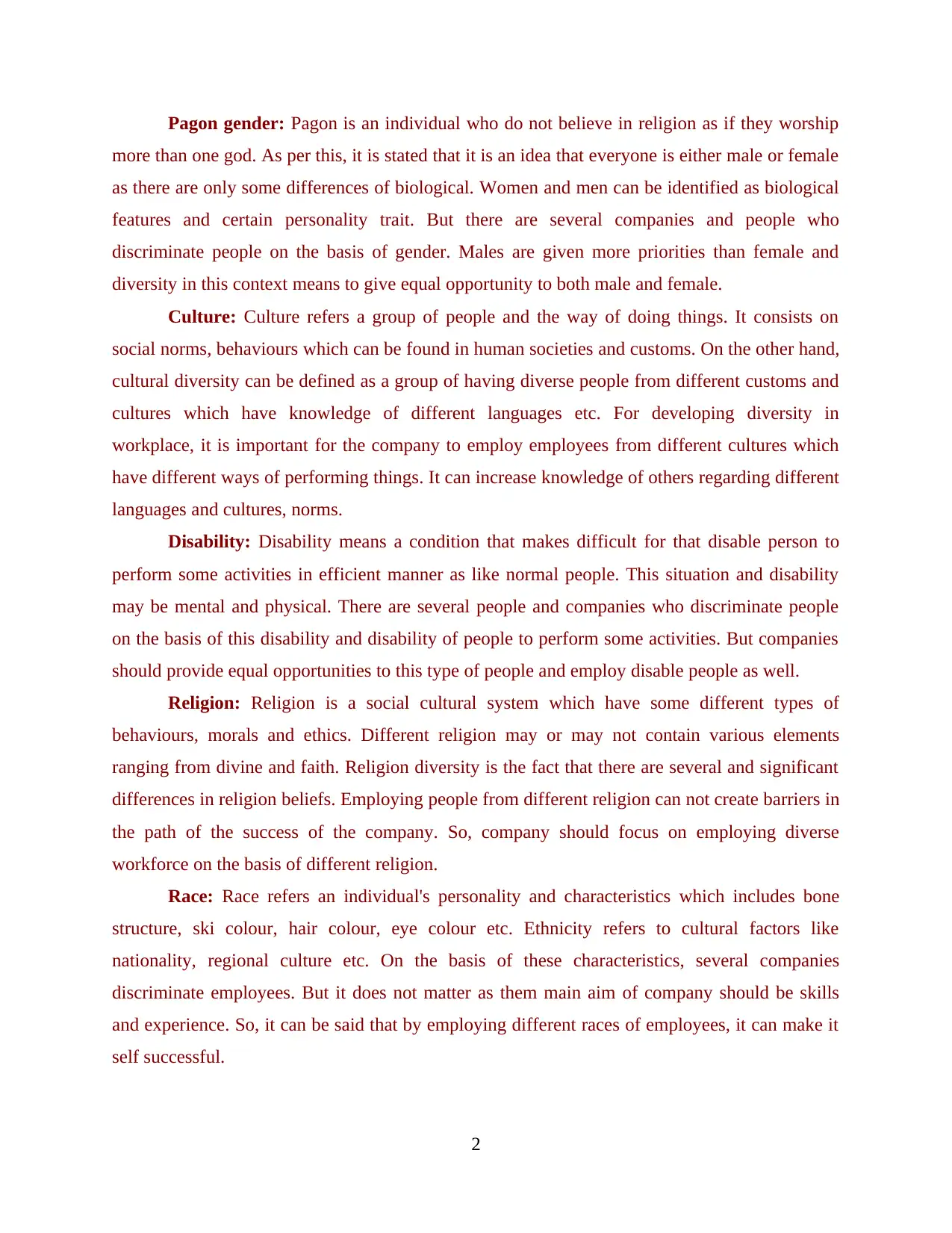
Pagon gender: Pagon is an individual who do not believe in religion as if they worship
more than one god. As per this, it is stated that it is an idea that everyone is either male or female
as there are only some differences of biological. Women and men can be identified as biological
features and certain personality trait. But there are several companies and people who
discriminate people on the basis of gender. Males are given more priorities than female and
diversity in this context means to give equal opportunity to both male and female.
Culture: Culture refers a group of people and the way of doing things. It consists on
social norms, behaviours which can be found in human societies and customs. On the other hand,
cultural diversity can be defined as a group of having diverse people from different customs and
cultures which have knowledge of different languages etc. For developing diversity in
workplace, it is important for the company to employ employees from different cultures which
have different ways of performing things. It can increase knowledge of others regarding different
languages and cultures, norms.
Disability: Disability means a condition that makes difficult for that disable person to
perform some activities in efficient manner as like normal people. This situation and disability
may be mental and physical. There are several people and companies who discriminate people
on the basis of this disability and disability of people to perform some activities. But companies
should provide equal opportunities to this type of people and employ disable people as well.
Religion: Religion is a social cultural system which have some different types of
behaviours, morals and ethics. Different religion may or may not contain various elements
ranging from divine and faith. Religion diversity is the fact that there are several and significant
differences in religion beliefs. Employing people from different religion can not create barriers in
the path of the success of the company. So, company should focus on employing diverse
workforce on the basis of different religion.
Race: Race refers an individual's personality and characteristics which includes bone
structure, ski colour, hair colour, eye colour etc. Ethnicity refers to cultural factors like
nationality, regional culture etc. On the basis of these characteristics, several companies
discriminate employees. But it does not matter as them main aim of company should be skills
and experience. So, it can be said that by employing different races of employees, it can make it
self successful.
2
more than one god. As per this, it is stated that it is an idea that everyone is either male or female
as there are only some differences of biological. Women and men can be identified as biological
features and certain personality trait. But there are several companies and people who
discriminate people on the basis of gender. Males are given more priorities than female and
diversity in this context means to give equal opportunity to both male and female.
Culture: Culture refers a group of people and the way of doing things. It consists on
social norms, behaviours which can be found in human societies and customs. On the other hand,
cultural diversity can be defined as a group of having diverse people from different customs and
cultures which have knowledge of different languages etc. For developing diversity in
workplace, it is important for the company to employ employees from different cultures which
have different ways of performing things. It can increase knowledge of others regarding different
languages and cultures, norms.
Disability: Disability means a condition that makes difficult for that disable person to
perform some activities in efficient manner as like normal people. This situation and disability
may be mental and physical. There are several people and companies who discriminate people
on the basis of this disability and disability of people to perform some activities. But companies
should provide equal opportunities to this type of people and employ disable people as well.
Religion: Religion is a social cultural system which have some different types of
behaviours, morals and ethics. Different religion may or may not contain various elements
ranging from divine and faith. Religion diversity is the fact that there are several and significant
differences in religion beliefs. Employing people from different religion can not create barriers in
the path of the success of the company. So, company should focus on employing diverse
workforce on the basis of different religion.
Race: Race refers an individual's personality and characteristics which includes bone
structure, ski colour, hair colour, eye colour etc. Ethnicity refers to cultural factors like
nationality, regional culture etc. On the basis of these characteristics, several companies
discriminate employees. But it does not matter as them main aim of company should be skills
and experience. So, it can be said that by employing different races of employees, it can make it
self successful.
2
Paraphrase This Document
Need a fresh take? Get an instant paraphrase of this document with our AI Paraphraser
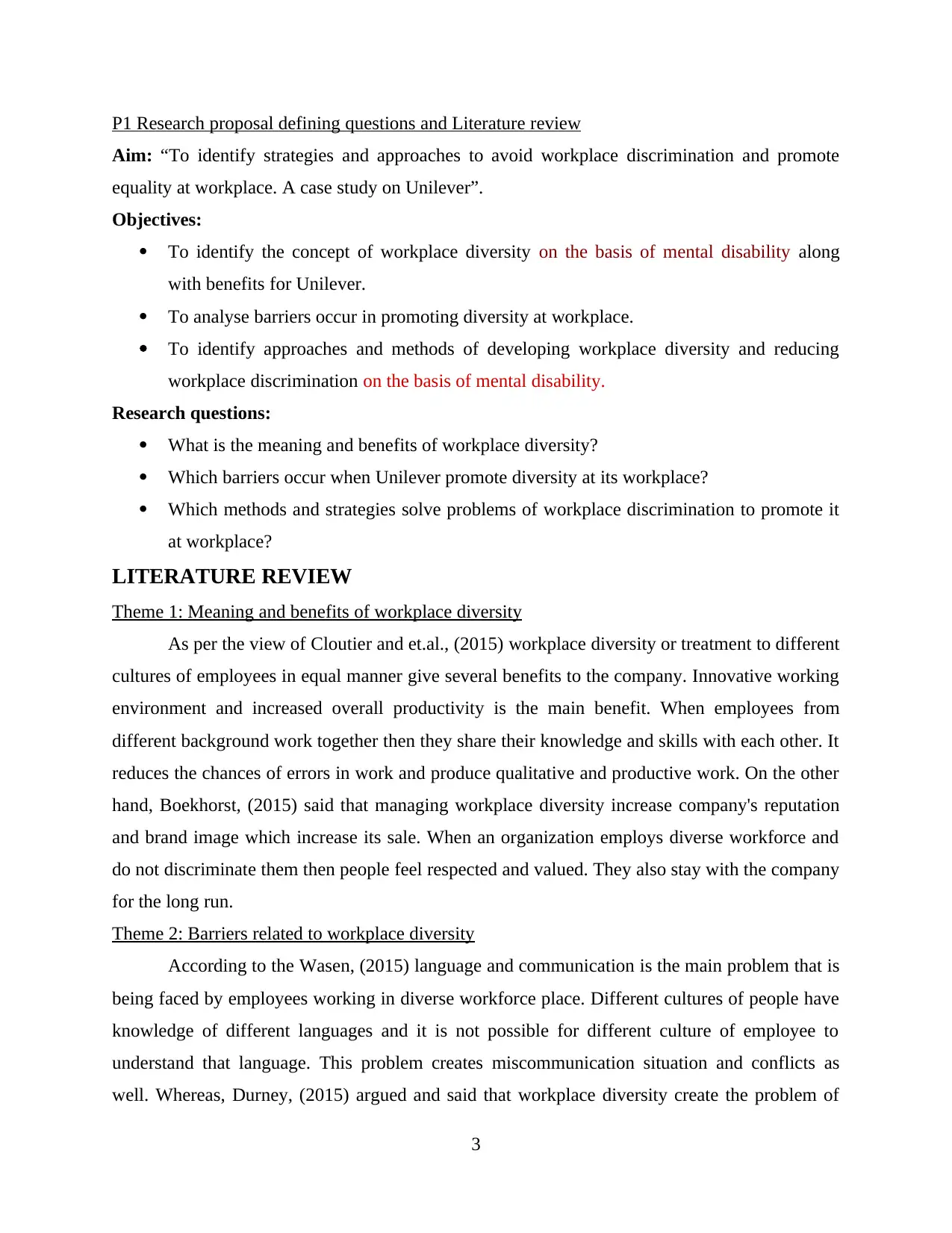
P1 Research proposal defining questions and Literature review
Aim: “To identify strategies and approaches to avoid workplace discrimination and promote
equality at workplace. A case study on Unilever”.
Objectives:
To identify the concept of workplace diversity on the basis of mental disability along
with benefits for Unilever.
To analyse barriers occur in promoting diversity at workplace.
To identify approaches and methods of developing workplace diversity and reducing
workplace discrimination on the basis of mental disability.
Research questions:
What is the meaning and benefits of workplace diversity?
Which barriers occur when Unilever promote diversity at its workplace?
Which methods and strategies solve problems of workplace discrimination to promote it
at workplace?
LITERATURE REVIEW
Theme 1: Meaning and benefits of workplace diversity
As per the view of Cloutier and et.al., (2015) workplace diversity or treatment to different
cultures of employees in equal manner give several benefits to the company. Innovative working
environment and increased overall productivity is the main benefit. When employees from
different background work together then they share their knowledge and skills with each other. It
reduces the chances of errors in work and produce qualitative and productive work. On the other
hand, Boekhorst, (2015) said that managing workplace diversity increase company's reputation
and brand image which increase its sale. When an organization employs diverse workforce and
do not discriminate them then people feel respected and valued. They also stay with the company
for the long run.
Theme 2: Barriers related to workplace diversity
According to the Wasen, (2015) language and communication is the main problem that is
being faced by employees working in diverse workforce place. Different cultures of people have
knowledge of different languages and it is not possible for different culture of employee to
understand that language. This problem creates miscommunication situation and conflicts as
well. Whereas, Durney, (2015) argued and said that workplace diversity create the problem of
3
Aim: “To identify strategies and approaches to avoid workplace discrimination and promote
equality at workplace. A case study on Unilever”.
Objectives:
To identify the concept of workplace diversity on the basis of mental disability along
with benefits for Unilever.
To analyse barriers occur in promoting diversity at workplace.
To identify approaches and methods of developing workplace diversity and reducing
workplace discrimination on the basis of mental disability.
Research questions:
What is the meaning and benefits of workplace diversity?
Which barriers occur when Unilever promote diversity at its workplace?
Which methods and strategies solve problems of workplace discrimination to promote it
at workplace?
LITERATURE REVIEW
Theme 1: Meaning and benefits of workplace diversity
As per the view of Cloutier and et.al., (2015) workplace diversity or treatment to different
cultures of employees in equal manner give several benefits to the company. Innovative working
environment and increased overall productivity is the main benefit. When employees from
different background work together then they share their knowledge and skills with each other. It
reduces the chances of errors in work and produce qualitative and productive work. On the other
hand, Boekhorst, (2015) said that managing workplace diversity increase company's reputation
and brand image which increase its sale. When an organization employs diverse workforce and
do not discriminate them then people feel respected and valued. They also stay with the company
for the long run.
Theme 2: Barriers related to workplace diversity
According to the Wasen, (2015) language and communication is the main problem that is
being faced by employees working in diverse workforce place. Different cultures of people have
knowledge of different languages and it is not possible for different culture of employee to
understand that language. This problem creates miscommunication situation and conflicts as
well. Whereas, Durney, (2015) argued and said that workplace diversity create the problem of
3
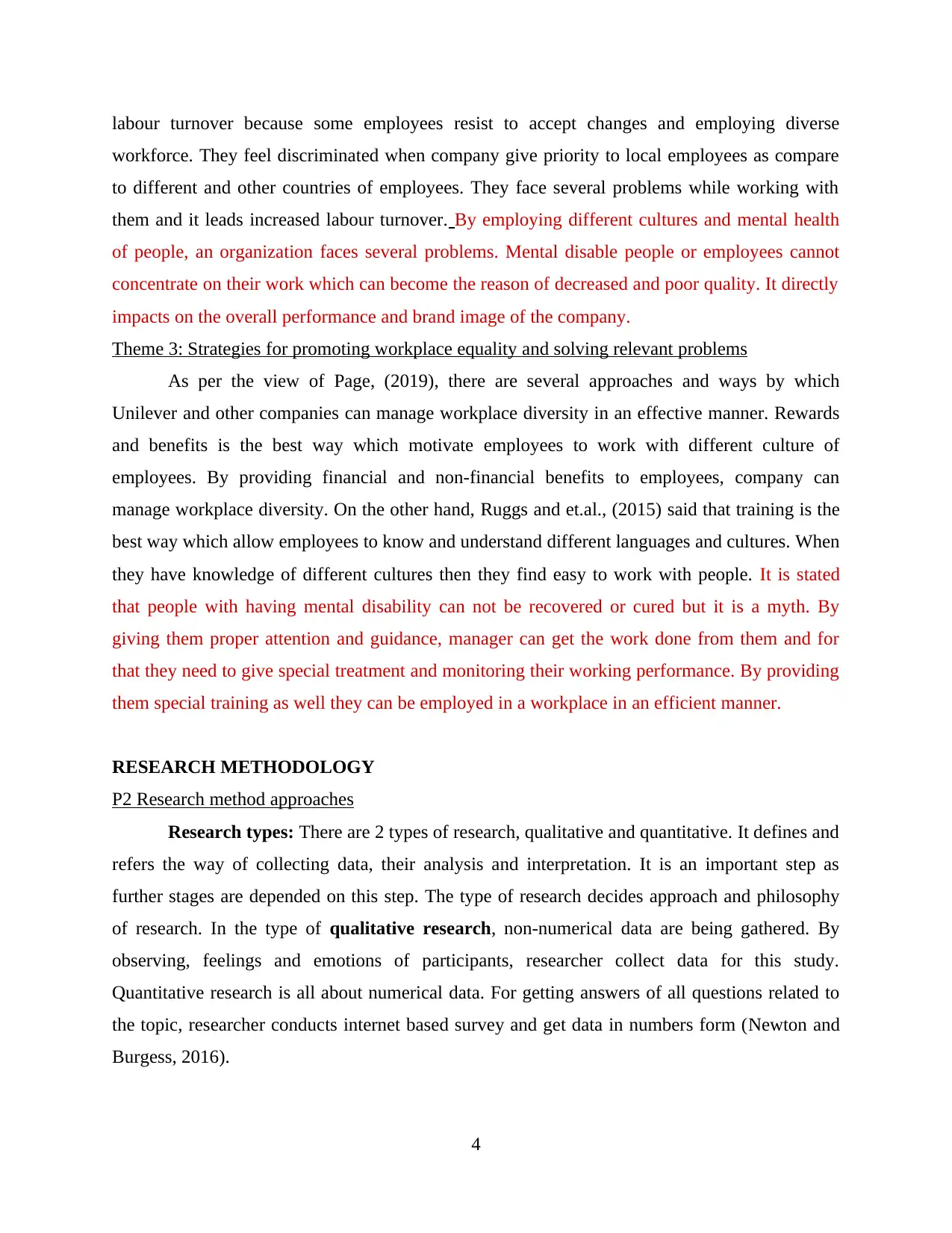
labour turnover because some employees resist to accept changes and employing diverse
workforce. They feel discriminated when company give priority to local employees as compare
to different and other countries of employees. They face several problems while working with
them and it leads increased labour turnover. By employing different cultures and mental health
of people, an organization faces several problems. Mental disable people or employees cannot
concentrate on their work which can become the reason of decreased and poor quality. It directly
impacts on the overall performance and brand image of the company.
Theme 3: Strategies for promoting workplace equality and solving relevant problems
As per the view of Page, (2019), there are several approaches and ways by which
Unilever and other companies can manage workplace diversity in an effective manner. Rewards
and benefits is the best way which motivate employees to work with different culture of
employees. By providing financial and non-financial benefits to employees, company can
manage workplace diversity. On the other hand, Ruggs and et.al., (2015) said that training is the
best way which allow employees to know and understand different languages and cultures. When
they have knowledge of different cultures then they find easy to work with people. It is stated
that people with having mental disability can not be recovered or cured but it is a myth. By
giving them proper attention and guidance, manager can get the work done from them and for
that they need to give special treatment and monitoring their working performance. By providing
them special training as well they can be employed in a workplace in an efficient manner.
RESEARCH METHODOLOGY
P2 Research method approaches
Research types: There are 2 types of research, qualitative and quantitative. It defines and
refers the way of collecting data, their analysis and interpretation. It is an important step as
further stages are depended on this step. The type of research decides approach and philosophy
of research. In the type of qualitative research, non-numerical data are being gathered. By
observing, feelings and emotions of participants, researcher collect data for this study.
Quantitative research is all about numerical data. For getting answers of all questions related to
the topic, researcher conducts internet based survey and get data in numbers form (Newton and
Burgess, 2016).
4
workforce. They feel discriminated when company give priority to local employees as compare
to different and other countries of employees. They face several problems while working with
them and it leads increased labour turnover. By employing different cultures and mental health
of people, an organization faces several problems. Mental disable people or employees cannot
concentrate on their work which can become the reason of decreased and poor quality. It directly
impacts on the overall performance and brand image of the company.
Theme 3: Strategies for promoting workplace equality and solving relevant problems
As per the view of Page, (2019), there are several approaches and ways by which
Unilever and other companies can manage workplace diversity in an effective manner. Rewards
and benefits is the best way which motivate employees to work with different culture of
employees. By providing financial and non-financial benefits to employees, company can
manage workplace diversity. On the other hand, Ruggs and et.al., (2015) said that training is the
best way which allow employees to know and understand different languages and cultures. When
they have knowledge of different cultures then they find easy to work with people. It is stated
that people with having mental disability can not be recovered or cured but it is a myth. By
giving them proper attention and guidance, manager can get the work done from them and for
that they need to give special treatment and monitoring their working performance. By providing
them special training as well they can be employed in a workplace in an efficient manner.
RESEARCH METHODOLOGY
P2 Research method approaches
Research types: There are 2 types of research, qualitative and quantitative. It defines and
refers the way of collecting data, their analysis and interpretation. It is an important step as
further stages are depended on this step. The type of research decides approach and philosophy
of research. In the type of qualitative research, non-numerical data are being gathered. By
observing, feelings and emotions of participants, researcher collect data for this study.
Quantitative research is all about numerical data. For getting answers of all questions related to
the topic, researcher conducts internet based survey and get data in numbers form (Newton and
Burgess, 2016).
4
⊘ This is a preview!⊘
Do you want full access?
Subscribe today to unlock all pages.

Trusted by 1+ million students worldwide
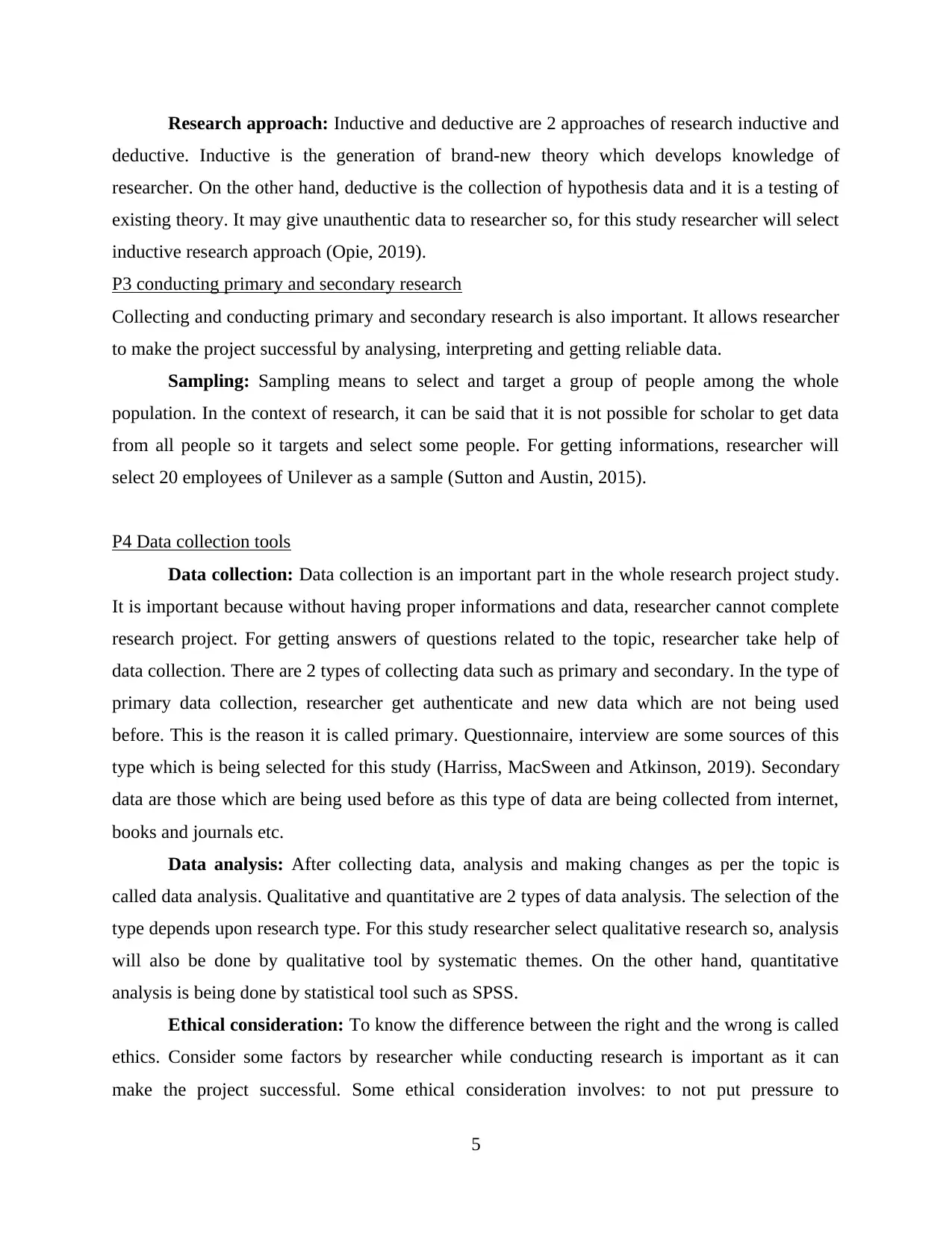
Research approach: Inductive and deductive are 2 approaches of research inductive and
deductive. Inductive is the generation of brand-new theory which develops knowledge of
researcher. On the other hand, deductive is the collection of hypothesis data and it is a testing of
existing theory. It may give unauthentic data to researcher so, for this study researcher will select
inductive research approach (Opie, 2019).
P3 conducting primary and secondary research
Collecting and conducting primary and secondary research is also important. It allows researcher
to make the project successful by analysing, interpreting and getting reliable data.
Sampling: Sampling means to select and target a group of people among the whole
population. In the context of research, it can be said that it is not possible for scholar to get data
from all people so it targets and select some people. For getting informations, researcher will
select 20 employees of Unilever as a sample (Sutton and Austin, 2015).
P4 Data collection tools
Data collection: Data collection is an important part in the whole research project study.
It is important because without having proper informations and data, researcher cannot complete
research project. For getting answers of questions related to the topic, researcher take help of
data collection. There are 2 types of collecting data such as primary and secondary. In the type of
primary data collection, researcher get authenticate and new data which are not being used
before. This is the reason it is called primary. Questionnaire, interview are some sources of this
type which is being selected for this study (Harriss, MacSween and Atkinson, 2019). Secondary
data are those which are being used before as this type of data are being collected from internet,
books and journals etc.
Data analysis: After collecting data, analysis and making changes as per the topic is
called data analysis. Qualitative and quantitative are 2 types of data analysis. The selection of the
type depends upon research type. For this study researcher select qualitative research so, analysis
will also be done by qualitative tool by systematic themes. On the other hand, quantitative
analysis is being done by statistical tool such as SPSS.
Ethical consideration: To know the difference between the right and the wrong is called
ethics. Consider some factors by researcher while conducting research is important as it can
make the project successful. Some ethical consideration involves: to not put pressure to
5
deductive. Inductive is the generation of brand-new theory which develops knowledge of
researcher. On the other hand, deductive is the collection of hypothesis data and it is a testing of
existing theory. It may give unauthentic data to researcher so, for this study researcher will select
inductive research approach (Opie, 2019).
P3 conducting primary and secondary research
Collecting and conducting primary and secondary research is also important. It allows researcher
to make the project successful by analysing, interpreting and getting reliable data.
Sampling: Sampling means to select and target a group of people among the whole
population. In the context of research, it can be said that it is not possible for scholar to get data
from all people so it targets and select some people. For getting informations, researcher will
select 20 employees of Unilever as a sample (Sutton and Austin, 2015).
P4 Data collection tools
Data collection: Data collection is an important part in the whole research project study.
It is important because without having proper informations and data, researcher cannot complete
research project. For getting answers of questions related to the topic, researcher take help of
data collection. There are 2 types of collecting data such as primary and secondary. In the type of
primary data collection, researcher get authenticate and new data which are not being used
before. This is the reason it is called primary. Questionnaire, interview are some sources of this
type which is being selected for this study (Harriss, MacSween and Atkinson, 2019). Secondary
data are those which are being used before as this type of data are being collected from internet,
books and journals etc.
Data analysis: After collecting data, analysis and making changes as per the topic is
called data analysis. Qualitative and quantitative are 2 types of data analysis. The selection of the
type depends upon research type. For this study researcher select qualitative research so, analysis
will also be done by qualitative tool by systematic themes. On the other hand, quantitative
analysis is being done by statistical tool such as SPSS.
Ethical consideration: To know the difference between the right and the wrong is called
ethics. Consider some factors by researcher while conducting research is important as it can
make the project successful. Some ethical consideration involves: to not put pressure to
5
Paraphrase This Document
Need a fresh take? Get an instant paraphrase of this document with our AI Paraphraser
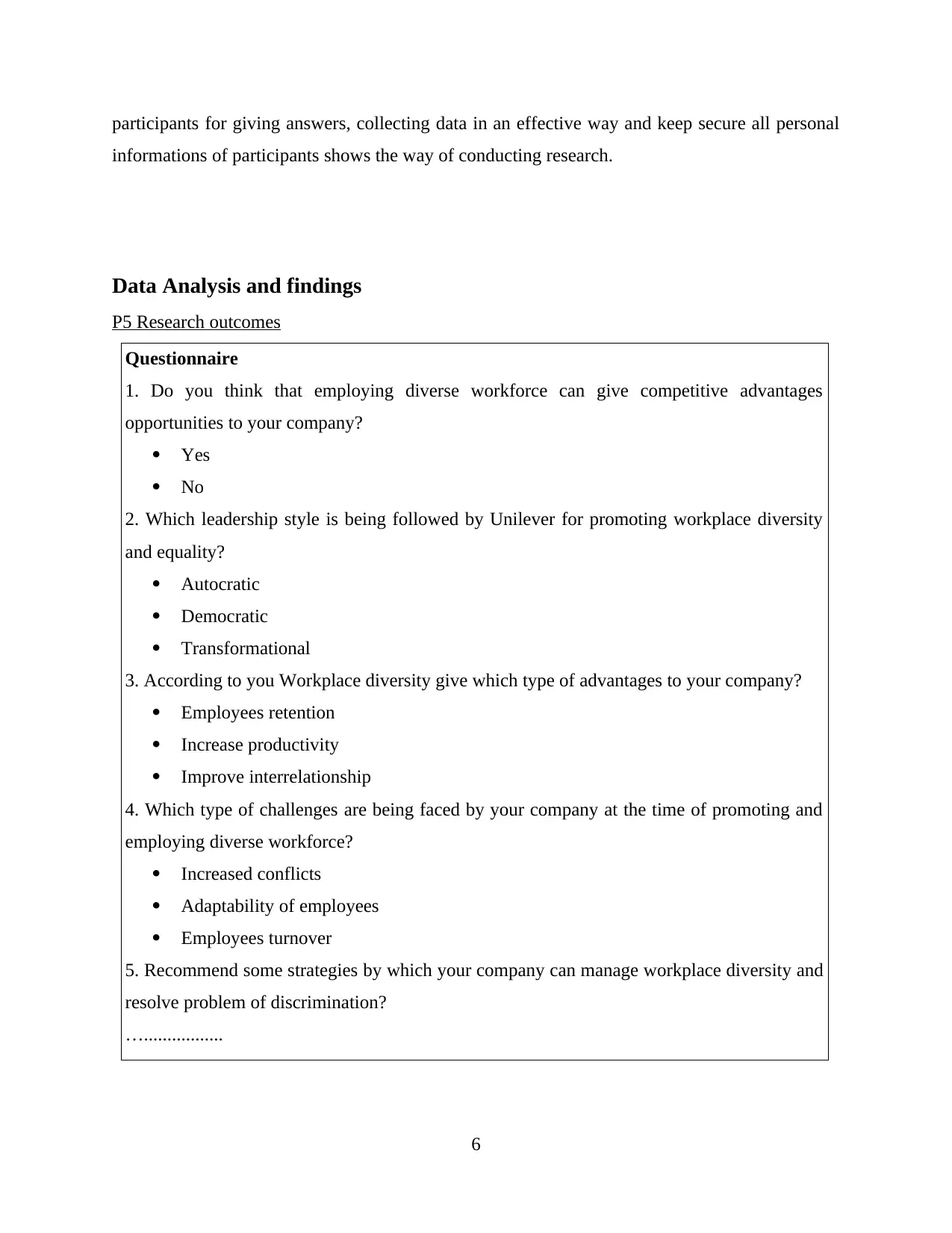
participants for giving answers, collecting data in an effective way and keep secure all personal
informations of participants shows the way of conducting research.
Data Analysis and findings
P5 Research outcomes
Questionnaire
1. Do you think that employing diverse workforce can give competitive advantages
opportunities to your company?
Yes
No
2. Which leadership style is being followed by Unilever for promoting workplace diversity
and equality?
Autocratic
Democratic
Transformational
3. According to you Workplace diversity give which type of advantages to your company?
Employees retention
Increase productivity
Improve interrelationship
4. Which type of challenges are being faced by your company at the time of promoting and
employing diverse workforce?
Increased conflicts
Adaptability of employees
Employees turnover
5. Recommend some strategies by which your company can manage workplace diversity and
resolve problem of discrimination?
….................
6
informations of participants shows the way of conducting research.
Data Analysis and findings
P5 Research outcomes
Questionnaire
1. Do you think that employing diverse workforce can give competitive advantages
opportunities to your company?
Yes
No
2. Which leadership style is being followed by Unilever for promoting workplace diversity
and equality?
Autocratic
Democratic
Transformational
3. According to you Workplace diversity give which type of advantages to your company?
Employees retention
Increase productivity
Improve interrelationship
4. Which type of challenges are being faced by your company at the time of promoting and
employing diverse workforce?
Increased conflicts
Adaptability of employees
Employees turnover
5. Recommend some strategies by which your company can manage workplace diversity and
resolve problem of discrimination?
….................
6
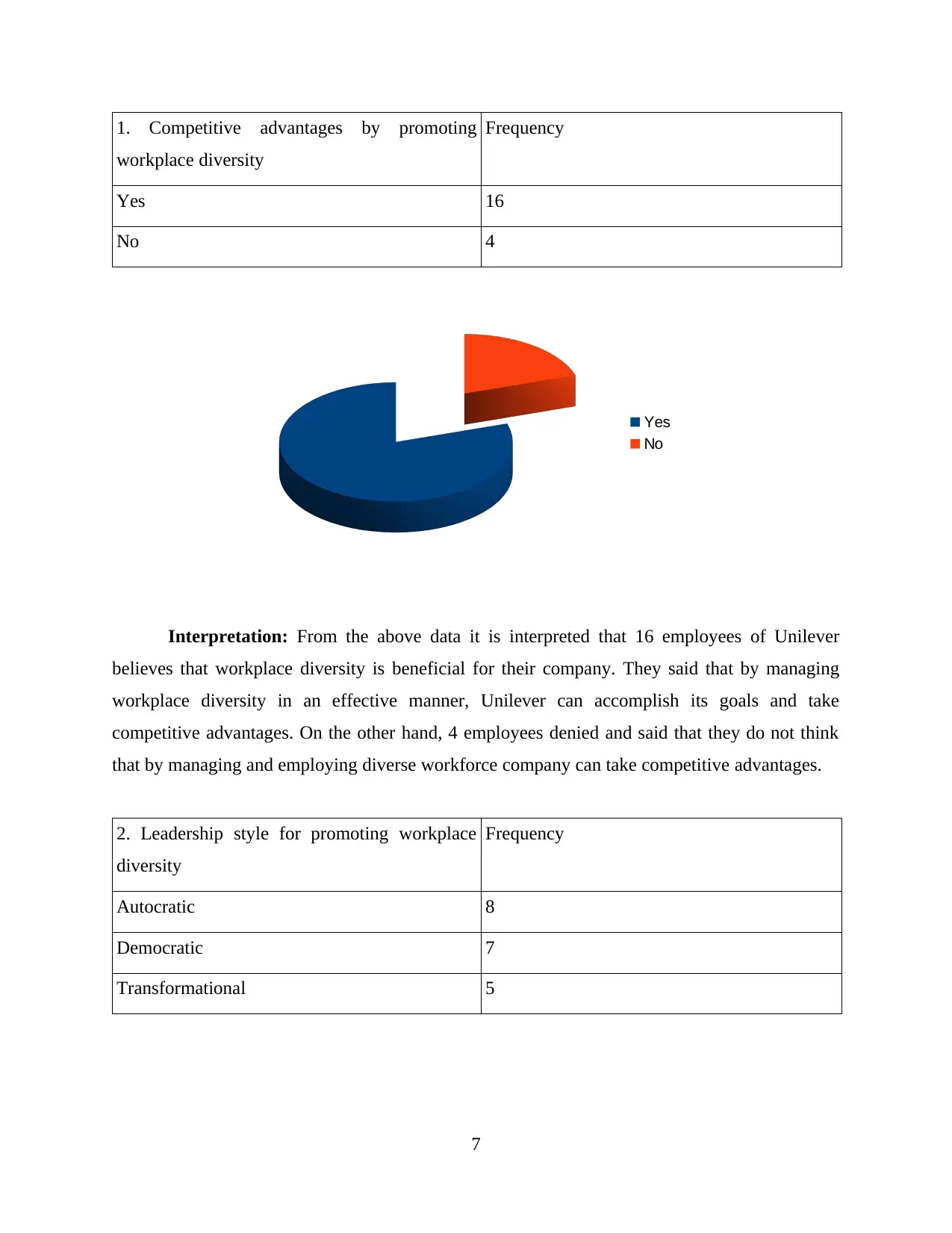
1. Competitive advantages by promoting
workplace diversity
Frequency
Yes 16
No 4
Interpretation: From the above data it is interpreted that 16 employees of Unilever
believes that workplace diversity is beneficial for their company. They said that by managing
workplace diversity in an effective manner, Unilever can accomplish its goals and take
competitive advantages. On the other hand, 4 employees denied and said that they do not think
that by managing and employing diverse workforce company can take competitive advantages.
2. Leadership style for promoting workplace
diversity
Frequency
Autocratic 8
Democratic 7
Transformational 5
7
Yes
No
workplace diversity
Frequency
Yes 16
No 4
Interpretation: From the above data it is interpreted that 16 employees of Unilever
believes that workplace diversity is beneficial for their company. They said that by managing
workplace diversity in an effective manner, Unilever can accomplish its goals and take
competitive advantages. On the other hand, 4 employees denied and said that they do not think
that by managing and employing diverse workforce company can take competitive advantages.
2. Leadership style for promoting workplace
diversity
Frequency
Autocratic 8
Democratic 7
Transformational 5
7
Yes
No
⊘ This is a preview!⊘
Do you want full access?
Subscribe today to unlock all pages.

Trusted by 1+ million students worldwide
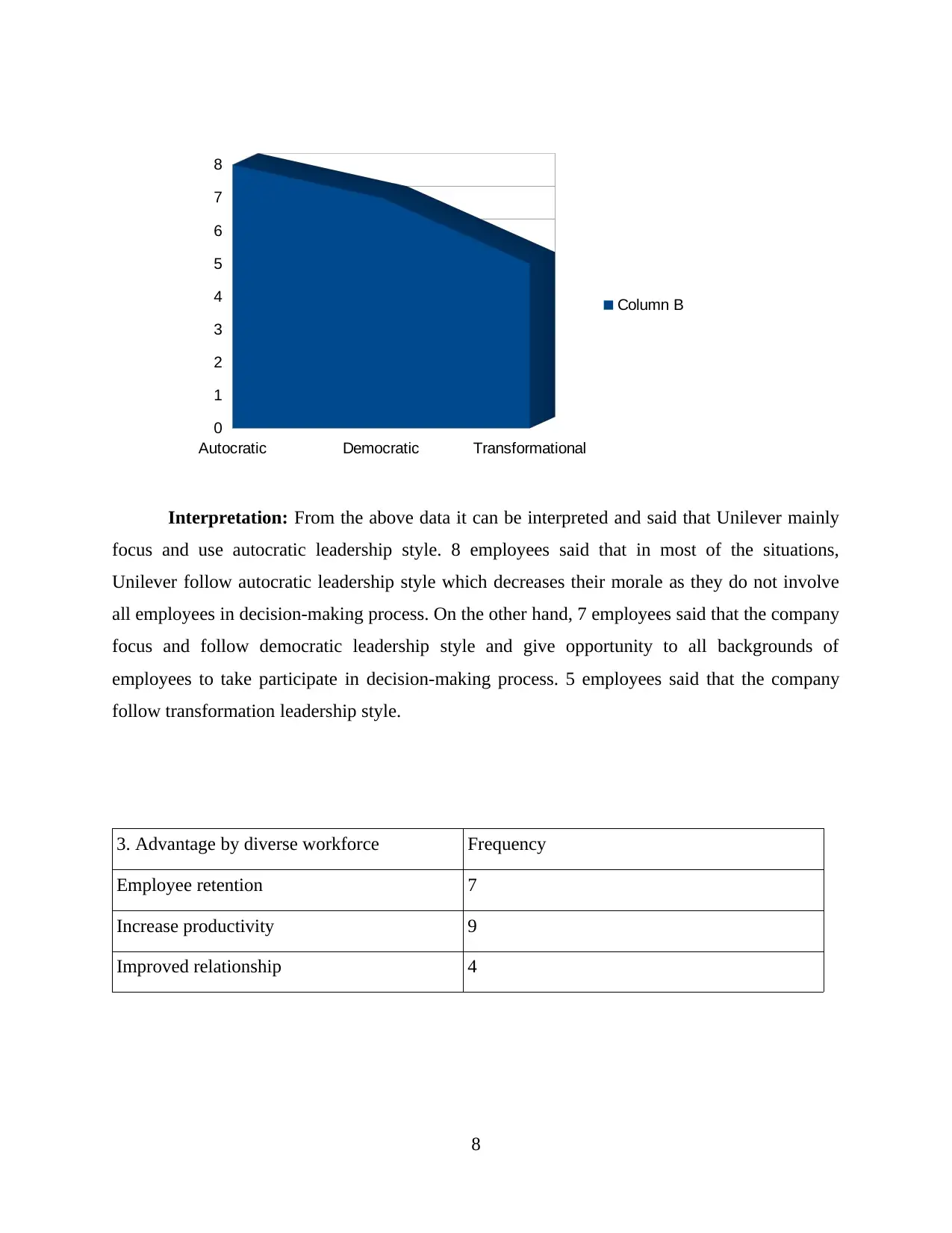
Interpretation: From the above data it can be interpreted and said that Unilever mainly
focus and use autocratic leadership style. 8 employees said that in most of the situations,
Unilever follow autocratic leadership style which decreases their morale as they do not involve
all employees in decision-making process. On the other hand, 7 employees said that the company
focus and follow democratic leadership style and give opportunity to all backgrounds of
employees to take participate in decision-making process. 5 employees said that the company
follow transformation leadership style.
3. Advantage by diverse workforce Frequency
Employee retention 7
Increase productivity 9
Improved relationship 4
8
Autocratic Democratic Transformational
0
1
2
3
4
5
6
7
8
Column B
focus and use autocratic leadership style. 8 employees said that in most of the situations,
Unilever follow autocratic leadership style which decreases their morale as they do not involve
all employees in decision-making process. On the other hand, 7 employees said that the company
focus and follow democratic leadership style and give opportunity to all backgrounds of
employees to take participate in decision-making process. 5 employees said that the company
follow transformation leadership style.
3. Advantage by diverse workforce Frequency
Employee retention 7
Increase productivity 9
Improved relationship 4
8
Autocratic Democratic Transformational
0
1
2
3
4
5
6
7
8
Column B
Paraphrase This Document
Need a fresh take? Get an instant paraphrase of this document with our AI Paraphraser
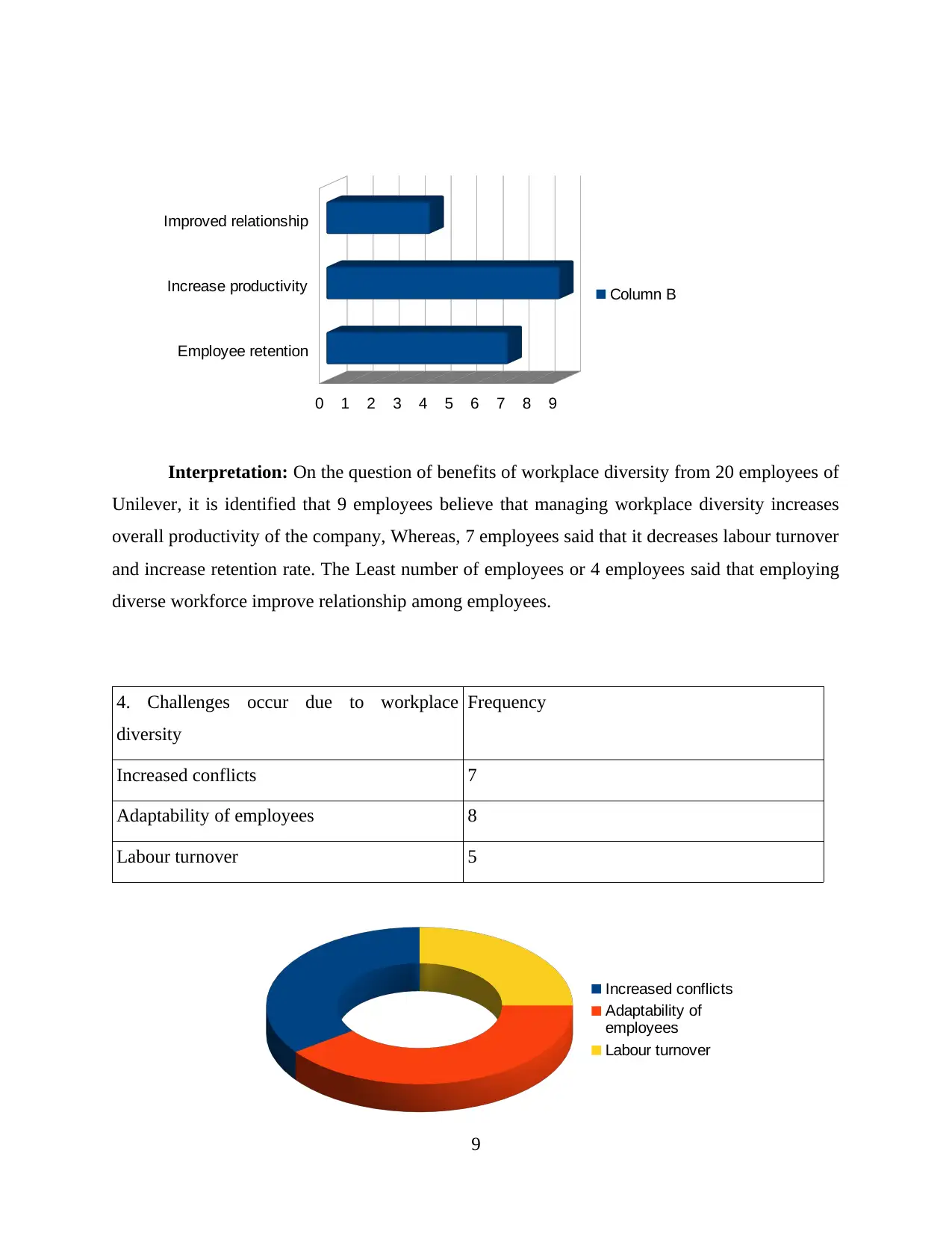
Interpretation: On the question of benefits of workplace diversity from 20 employees of
Unilever, it is identified that 9 employees believe that managing workplace diversity increases
overall productivity of the company, Whereas, 7 employees said that it decreases labour turnover
and increase retention rate. The Least number of employees or 4 employees said that employing
diverse workforce improve relationship among employees.
4. Challenges occur due to workplace
diversity
Frequency
Increased conflicts 7
Adaptability of employees 8
Labour turnover 5
9
Employee retention
Increase productivity
Improved relationship
0 1 2 3 4 5 6 7 8 9
Column B
Increased conflicts
Adaptability of
employees
Labour turnover
Unilever, it is identified that 9 employees believe that managing workplace diversity increases
overall productivity of the company, Whereas, 7 employees said that it decreases labour turnover
and increase retention rate. The Least number of employees or 4 employees said that employing
diverse workforce improve relationship among employees.
4. Challenges occur due to workplace
diversity
Frequency
Increased conflicts 7
Adaptability of employees 8
Labour turnover 5
9
Employee retention
Increase productivity
Improved relationship
0 1 2 3 4 5 6 7 8 9
Column B
Increased conflicts
Adaptability of
employees
Labour turnover
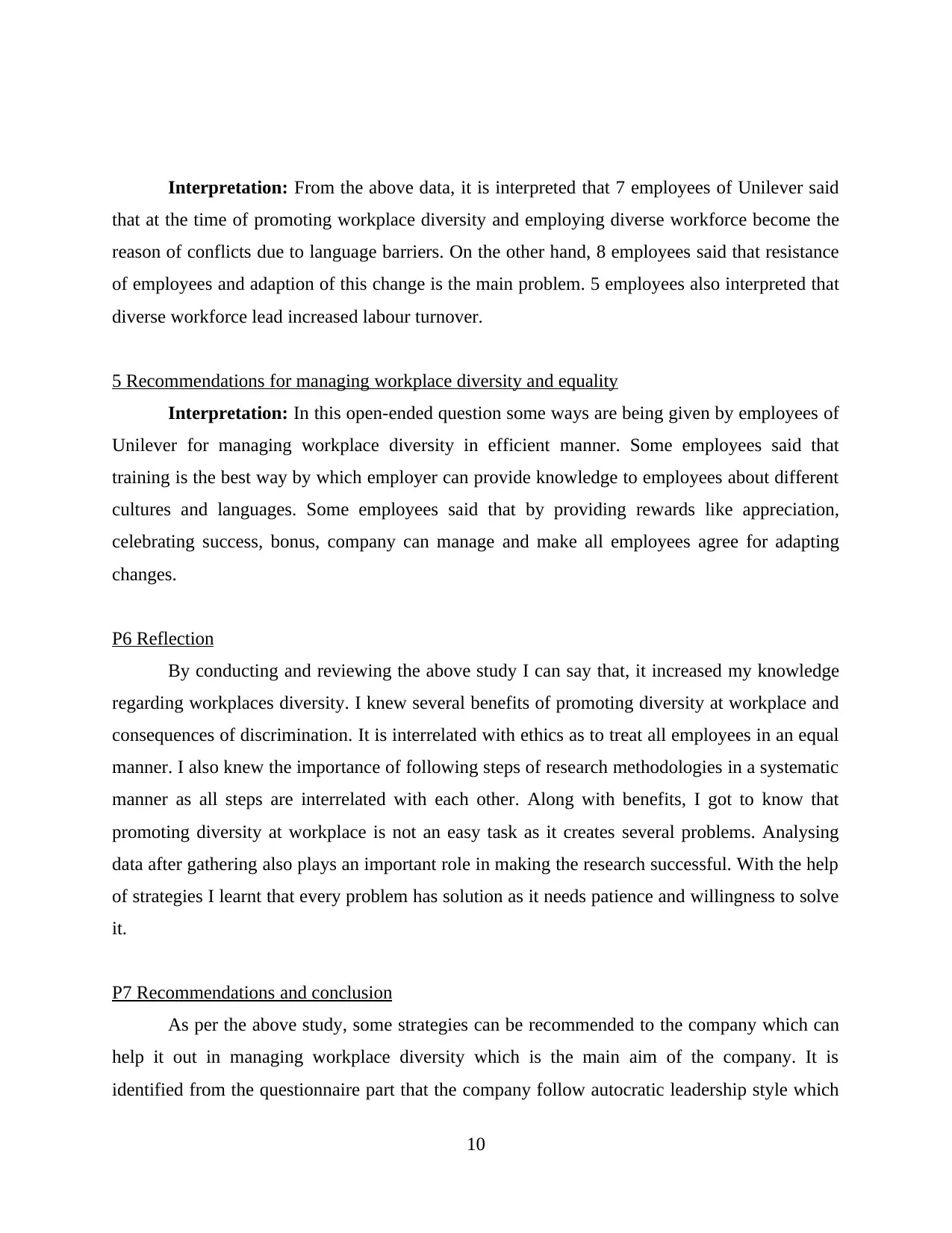
Interpretation: From the above data, it is interpreted that 7 employees of Unilever said
that at the time of promoting workplace diversity and employing diverse workforce become the
reason of conflicts due to language barriers. On the other hand, 8 employees said that resistance
of employees and adaption of this change is the main problem. 5 employees also interpreted that
diverse workforce lead increased labour turnover.
5 Recommendations for managing workplace diversity and equality
Interpretation: In this open-ended question some ways are being given by employees of
Unilever for managing workplace diversity in efficient manner. Some employees said that
training is the best way by which employer can provide knowledge to employees about different
cultures and languages. Some employees said that by providing rewards like appreciation,
celebrating success, bonus, company can manage and make all employees agree for adapting
changes.
P6 Reflection
By conducting and reviewing the above study I can say that, it increased my knowledge
regarding workplaces diversity. I knew several benefits of promoting diversity at workplace and
consequences of discrimination. It is interrelated with ethics as to treat all employees in an equal
manner. I also knew the importance of following steps of research methodologies in a systematic
manner as all steps are interrelated with each other. Along with benefits, I got to know that
promoting diversity at workplace is not an easy task as it creates several problems. Analysing
data after gathering also plays an important role in making the research successful. With the help
of strategies I learnt that every problem has solution as it needs patience and willingness to solve
it.
P7 Recommendations and conclusion
As per the above study, some strategies can be recommended to the company which can
help it out in managing workplace diversity which is the main aim of the company. It is
identified from the questionnaire part that the company follow autocratic leadership style which
10
that at the time of promoting workplace diversity and employing diverse workforce become the
reason of conflicts due to language barriers. On the other hand, 8 employees said that resistance
of employees and adaption of this change is the main problem. 5 employees also interpreted that
diverse workforce lead increased labour turnover.
5 Recommendations for managing workplace diversity and equality
Interpretation: In this open-ended question some ways are being given by employees of
Unilever for managing workplace diversity in efficient manner. Some employees said that
training is the best way by which employer can provide knowledge to employees about different
cultures and languages. Some employees said that by providing rewards like appreciation,
celebrating success, bonus, company can manage and make all employees agree for adapting
changes.
P6 Reflection
By conducting and reviewing the above study I can say that, it increased my knowledge
regarding workplaces diversity. I knew several benefits of promoting diversity at workplace and
consequences of discrimination. It is interrelated with ethics as to treat all employees in an equal
manner. I also knew the importance of following steps of research methodologies in a systematic
manner as all steps are interrelated with each other. Along with benefits, I got to know that
promoting diversity at workplace is not an easy task as it creates several problems. Analysing
data after gathering also plays an important role in making the research successful. With the help
of strategies I learnt that every problem has solution as it needs patience and willingness to solve
it.
P7 Recommendations and conclusion
As per the above study, some strategies can be recommended to the company which can
help it out in managing workplace diversity which is the main aim of the company. It is
identified from the questionnaire part that the company follow autocratic leadership style which
10
⊘ This is a preview!⊘
Do you want full access?
Subscribe today to unlock all pages.

Trusted by 1+ million students worldwide
1 out of 17
Related Documents
Your All-in-One AI-Powered Toolkit for Academic Success.
+13062052269
info@desklib.com
Available 24*7 on WhatsApp / Email
![[object Object]](/_next/static/media/star-bottom.7253800d.svg)
Unlock your academic potential
Copyright © 2020–2025 A2Z Services. All Rights Reserved. Developed and managed by ZUCOL.





